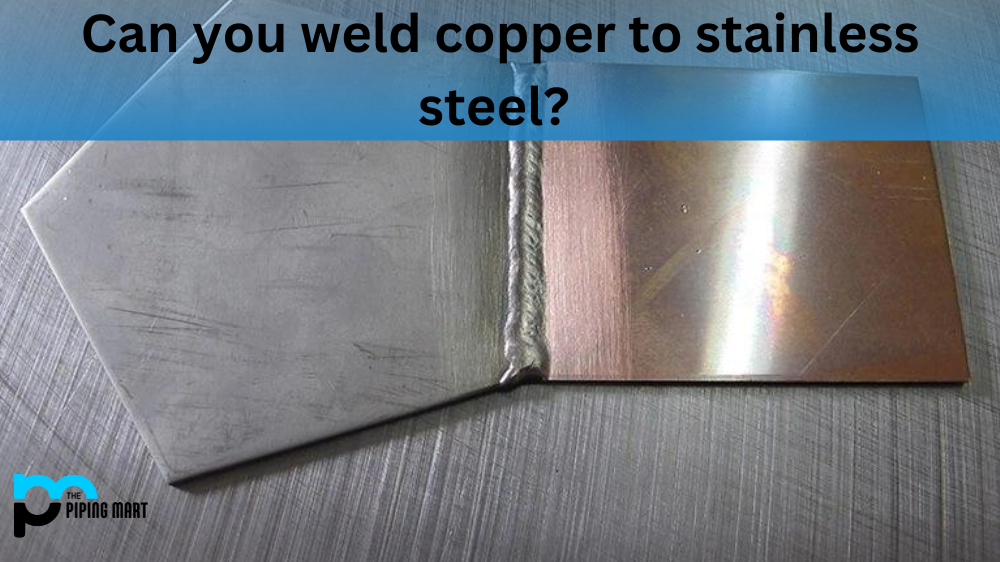If you’re working on a project that requires welding copper to stainless steel, you’ve probably noticed the challenge. Welding copper and stainless steel together aren’t as straightforward as welding two pieces of the same material. So, can you weld copper to stainless steel? The answer is yes, but you should keep a few things in mind before starting your project.
The simple answer is yes; you can weld copper to stainless steel using specific processes. However, before attempting any welding project, it is important to understand the metal used and the best practices for joining them. Let’s take a look at both stainless steel and copper in more detail.
What is Stainless Steel?
Stainless steel is an iron, carbon, and chromium alloy that prevents rusting or corrosion. It is one of the most popular metals used in metalworking because of its strength and durability. While it can be difficult to weld due to its high melting point, it can be done with practice and patience.
What is Copper?
Copper has some excellent qualities, such as electrical conductivity and moisture corrosion resistance—making it perfect for plumbing applications where water may be present. It also has a relatively low melting point compared to stainless steel, so it may be easier to work with when welding together two metals with different melting points.
Welding Copper & Stainless Steel Together:
When welding copper and stainless steel together, it’s important to remember that copper melts at a much lower temperature than stainless steel does. This means that if too much heat is applied during the welding process, the copper will melt before the stainless steel does—causing problems such as gaps in the joint or poor weld quality due to uneven heating between the two metals. To avoid this issue, use an inert gas such as argon when welding these two metals together. Argon will prevent oxidation while providing enough heat for a successful weld without overheating either metal!
Welding Process
When it comes to welding copper and stainless steel together, the process is relatively simple. First, you’ll need to ensure that both materials are clean and debris-free. This will help ensure that the weld forms properly and securely bonds the two metals together. Then, apply flux to the seam where the two metals meet. This will reduce oxidation during the welding process, which can cause problems with your welds over time if not addressed properly.
Next, use an oxy-acetylene torch to heat both materials until they reach their melting points. Once both metals have been heated up sufficiently, use a filler rod made of nickel-copper alloy or aluminum-silicon bronze and join them together by creating a fillet weld along their edges. Finally, let everything cool down before taking it off your workstation—you don’t want all your hard work wasted because it wasn’t given enough time to solidify!
- Use a wire brush to remove any rust or dirt from the surface of the copper.
- Apply a thin layer of welding flux to the surface of the copper.
- Place the copper and stainless steel together so that they are flush.
- Begin welding at the edge of the joint, working your way around in a clockwise or counterclockwise direction.
- Allow the weld to cool for a few minutes before handling it.
Special Considerations
Welding copper and stainless steel together require special considerations due to their different properties when heated up. For instance, stainless steel has a higher thermal conductivity than copper; heat is dispersed faster when working with stainless steel than with other metals or alloys like copper. As such, make sure that your torch settings are adjusted accordingly so that you don’t end up overheating one piece while trying to get enough heat into the other one. It also pays off to invest in quality welding gloves since these will help protect your hands from any contact burns due to hot metal touching skin during the process; safety should always be your top priority when working with high temperatures!
Conclusion:
In conclusion, welding copper and stainless steel together aren’t impossible, but it does require special considerations due to their different properties when heated up. Be sure that both materials are clean first before applying flux and then heating them up using an oxy-acetylene torch until they reach their melting points before joining them together using a filler rod made out of nickel-copper alloy or aluminum-silicon bronze for maximum strength and durability in resultant bond. Investing in quality protective gear like welding gloves is also highly recommended for safety purposes during this type of job! With these tips in mind, anyone who knows how to weld can successfully join these two different types of metal together!




